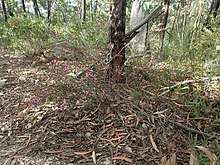Boronia hapalophylla
Boronia hapalophylla is a plant in the citrus family Rutaceae and is endemic to New South Wales. It is an erect or straggling shrub with simple leaves, hairy branches and relatively large pink, four-petalled flowers.
| Shannon Creek boronia | |
|---|---|
.jpg) | |
| Boronia hapalophylla in the Sherwood Nature Reserve near Glenreagh | |
| Scientific classification | |
| Kingdom: | Plantae |
| Clade: | Tracheophytes |
| Clade: | Angiosperms |
| Clade: | Eudicots |
| Clade: | Rosids |
| Order: | Sapindales |
| Family: | Rutaceae |
| Genus: | Boronia |
| Species: | B. hapalophylla |
| Binomial name | |
| Boronia hapalophylla | |
 | |
| Occurrence data from Australasian Virtual Herbarium | |

Description
Boronia hapalophylla is an erect or straggling shrub that grows to about 3 m (10 ft) high and has branches with minute, star-like hairs. The leaves are simple, narrow elliptic to lance-shaped, mostly 18–50 mm (0.7–2 in) long, 3.5–12 mm (0.1–0.5 in) wide with a hairy, paler underside and the edges rolled down. The leaves are sessile or sometimes have a petiole up to 1.5 mm (0.06 in) long. The flowers are pink, sometimes white and are arranged singly or in groups of up to seven in leaf axils, the groups on a peduncle up to 5 mm (0.2 in) long (if present), the individual flowers on a pedicel 2–6.5 mm (0.08–0.3 in) long. The four sepals are broadly egg-shaped to triangular, mostly 5–10 mm (0.2–0.4 in) long, 3–4.5 mm (0.1–0.2 in) wide and hairy on the back. The four petals are 6–15 mm (0.2–0.6 in) long and densely hairy on the back. Flowering occurs mainly in August and September.[2][3][4][5]
Taxonomy and naming
Boronia hapalophylla was first formally described in 2004 by Marco Duretto, John Edwards and Patricia Edwards who published the description in the journal Telopea.[6][2] The specific epithet (hapalophylla) is said to be derived from the Ancient Greek word hapalo meaning "soft to touch" and phyllus meaning "leaf", referring to the soft, hairy surface of the leaves.[2] In Ancient Greek "soft to touch" and "leaf" are however hapalos (ἁπαλός) and phyllon (φύλλον).[7]
Distribution and habitat
This boronia is restricted to an area between Coutts Crossing and Shannon Creek near Glenreagh where it grows in woodland and in thick gully vegetation.
Conservation
Boronia hapalophylla is listed as "endangered" under the New South Wales Government Biodiversity Conservation Act 2016. The main threats to the species include habitat disturbance, weed invasion and trampling by domestic stock and feral herbivores.[5]
References
- "Boronia hapalophylla". Australian Plant Census. Retrieved 14 March 2019.
- Duretto, Marco F.; Edwards, F. John; Edwards, Patricia G. (2004). "Boronia hapalophylla (Rutaceae), a new and restricted species from north-eastern New South Wales". Telopea. 10 (3): 705–710.
- Duretto, Marco F.; Wilson, Paul G.; Ladiges, Pauline Y. "Boronia hapalophylla". Australian Biological Resources Study, Department of the Environment and Energy, Canberra. Retrieved 17 March 2019.
- Duretto, Marco F.; Edwards, F. John; Edwards, Patricia G. "Boronia hapalophylla". Royal Botanic Garden Sydney. Retrieved 17 March 2019.
- "Shannon Creek Boronia - profile". New South Wales Government Office of Environment and Heritage. Retrieved 17 March 2019.
- "Boronia hapalophylla". APNI. Retrieved 17 March 2019.
- Liddell, H.G. & Scott, R. (1940). A Greek-English Lexicon. Revised and augmented throughout by Sir Henry Stuart Jones with the assistance of Roderick McKenzie.Oxford: Clarendon Press.
